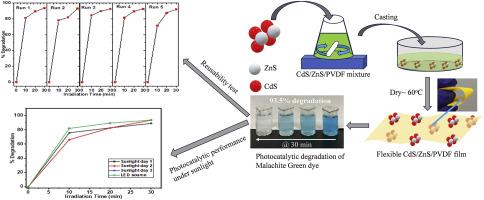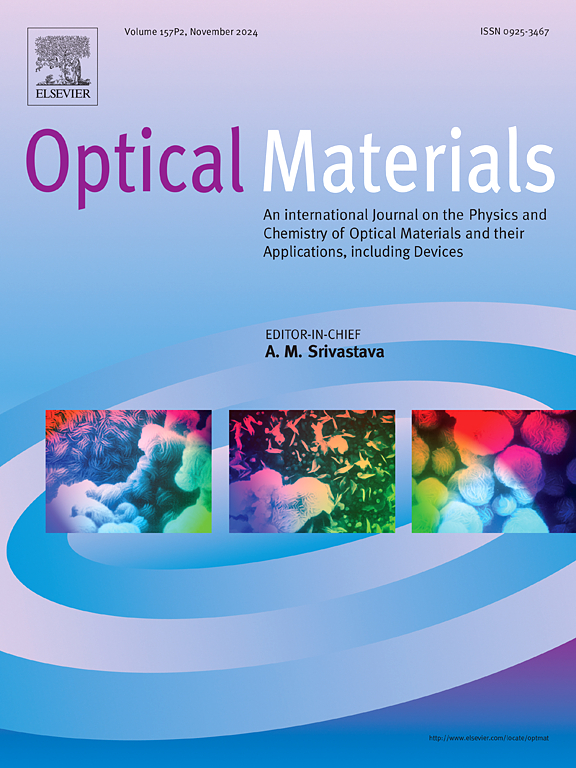Development of flexible and mesoporous CdS/ZnS/PVDF nanocomposites with remarkable organic dye degradation performance under natural sunlight
IF 3.8
3区 材料科学
Q2 MATERIALS SCIENCE, MULTIDISCIPLINARY
引用次数: 0
Abstract
The engineering of polymer-based nanocomposites is a highly promising strategy for improving both the efficiency and stability of catalysts used in wastewater treatment. In this work, we explore the efficacy of flexible CdS/ZnS/PVDF nanocomposite films towards degradation of Malachite Green dye under low energy visible light and ambient sunlight. Films with varying weight percentage of CdS/ZnS nanofillers (0 %, 5 %, 10 %, 15 %, 20 %) were successfully prepared by solution casting method and the physiochemical properties were characterized using various techniques such as XRD, SEM, AFM, EDX, BET, UV–Vis DRS and FTIR. Pore diameter of 5.5 nm was observed, indicating that CdS/ZnS is mesoporous in nature. Under the optimum photocatalytic condition of 15 ppm dye concentration and pH 9, 15 wt% CdS/ZnS/PVDF showed the maximum photodegradation efficiency of 93.5 % in 30 min. The sample exhibited excellent reusability for five consecutive runs of the experiments which show a degradation percentage of 92.1 % in the fifth run and the scavenging study established that superoxide radicals play the major role in the photodegradation process. The experiments under natural sunlight on three separate days showed a remarkable photodegradation performance of 89 %, 93.4 % and 93.6 % highlighting the potential of CdS/ZnS/PVDF nanocomposites for sustainable wastewater treatment under natural sunlight.

开发在自然光下具有显著有机染料降解性能的柔性介孔 CdS/ZnS/PVDF 纳米复合材料
聚合物基纳米复合材料工程是一种非常有前途的策略,可提高用于废水处理的催化剂的效率和稳定性。在这项研究中,我们探讨了柔性 CdS/ZnS/PVDF 纳米复合薄膜在低能可见光和环境日光下降解孔雀石绿染料的功效。采用溶液浇铸法成功制备了不同重量百分比的 CdS/ZnS 纳米填料薄膜(0%、5%、10%、15%、20%),并使用 XRD、SEM、AFM、EDX、BET、UV-Vis DRS 和 FTIR 等多种技术对其理化性质进行了表征。观察到的孔径为 5.5 nm,表明 CdS/ZnS 具有介孔性质。在染料浓度为 15 ppm、pH 值为 9 的最佳光催化条件下,15 wt% 的 CdS/ZnS/PVDF 在 30 分钟内的光降解效率最高,达到 93.5%。该样品在连续五次实验中都表现出极佳的重复利用率,第五次实验中的降解率达到 92.1%,清除研究证实超氧自由基在光降解过程中发挥了主要作用。在自然阳光下分别进行的三天实验表明,CdS/ZnS/PVDF 纳米复合材料的光降解性能分别为 89%、93.4% 和 93.6%,这突出表明了 CdS/ZnS/PVDF 纳米复合材料在自然阳光下可持续处理废水的潜力。
本文章由计算机程序翻译,如有差异,请以英文原文为准。
求助全文
约1分钟内获得全文
求助全文
来源期刊

Optical Materials
工程技术-材料科学:综合
CiteScore
6.60
自引率
12.80%
发文量
1265
审稿时长
38 days
期刊介绍:
Optical Materials has an open access mirror journal Optical Materials: X, sharing the same aims and scope, editorial team, submission system and rigorous peer review.
The purpose of Optical Materials is to provide a means of communication and technology transfer between researchers who are interested in materials for potential device applications. The journal publishes original papers and review articles on the design, synthesis, characterisation and applications of optical materials.
OPTICAL MATERIALS focuses on:
• Optical Properties of Material Systems;
• The Materials Aspects of Optical Phenomena;
• The Materials Aspects of Devices and Applications.
Authors can submit separate research elements describing their data to Data in Brief and methods to Methods X.
 求助内容:
求助内容: 应助结果提醒方式:
应助结果提醒方式:


